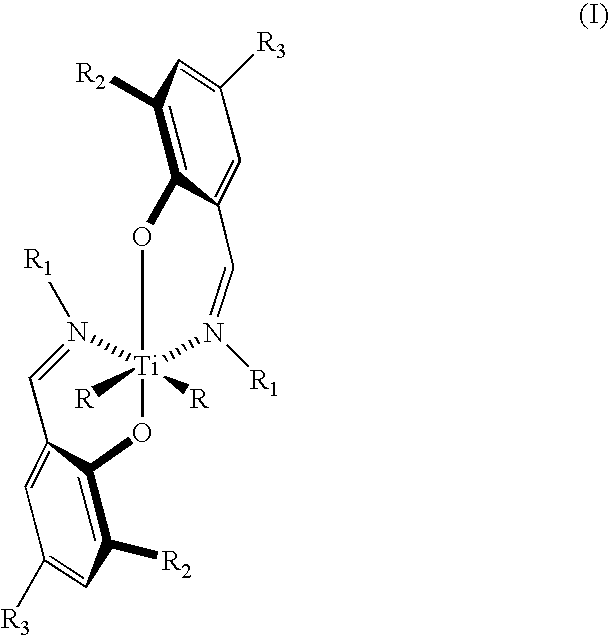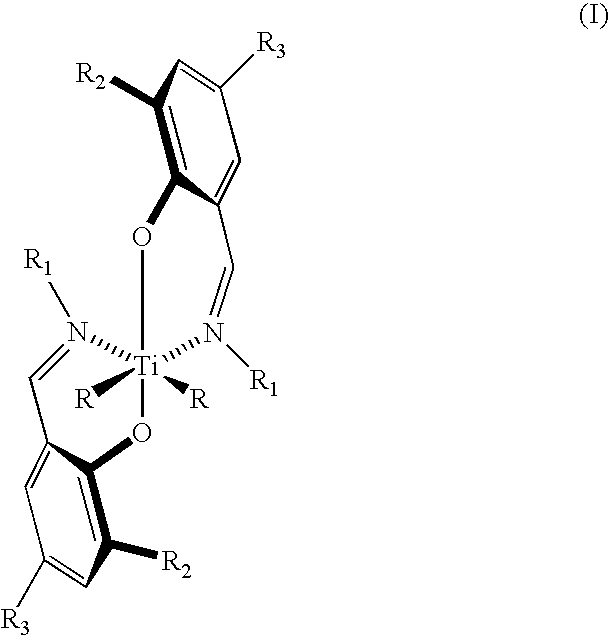Bis (salicylaldiminato) titanium complex catalysts, highly syndiotactic polypropylene by a chain-end control mechanism, block copolymer containing this
a technology of titanium complex and chain-end control mechanism, which is applied in the direction of group 4/14 organic compounds without c-metal linkages, chemical/physical processes, etc., can solve the problems of lack of clarity of isotactic polypropylene, unusable, and unusable in hot liquid containers
- Summary
- Abstract
- Description
- Claims
- Application Information
AI Technical Summary
Benefits of technology
Problems solved by technology
Method used
Image
Examples
sixth embodiment
where n ranges from 1 to 750. In the formula (II), n is the number of propylene units in the polymer or oligomer except for the olefin terminating end groups. Specific examples of this embodiment have the formula (II), where n=1, 2, 3, 4, 10, 20, 50 or 100. These polymers and oligomers are prepared by a method comprising polymerizing propylene in a method which does not give living polymerization, e.g., in the method of the invention described below.
[0042]We turn now to the sixth embodiment of the invention which is directed to a method of preparing polymers and oligomers of propylene having the structure (II) where n ranges from 1 to 750 comprising polymerizing propylene in an aprotic solvent, preferably as a saturated solution, in the presence of a catalytically effective amount of complex having the structure (I) where R is selected from the group consisting of halogen atoms, C1–C10 branched or straight chain alkyl groups, C1–C6 branched or straight chain alkoxide groups, and C1–...
example i
Synthesis of Complex A
[0051]To a 250 mL Schlenk tube, 20 mL of methanol, 1.860 g (20 mmol) aniline and 4.687 g (20 mmol) 3,5-di-tert-butylsalicylaldehyde were introduced, and then heated up to reflux for 8 h. Upon reducing the solvent volume and cooling down afforded a bright brown crystals of Ligand A, which was isolated and dried under vacuum (5.882 g, 95%). 1H-NMR spectrum showed that it was the desired product. 1H NMR (CDCl3, ppm, 20° C.): δ 1.32 (s, C(CH3)3, 9H), 1.47 (s, C(CH3)3 9H), 7.18–7.30 (m, Ar, 4H), 7.36–7.46 (m, Ar, 3H), 8.63 (s, CH, 1H). Ligand A (0.718 g, 2 mmol) was dissolved in 20 mL Et2O in a pre-dried Schlenk tube under nitrogen. At −60° C., the ligand solution was treated dropwise by nBuLi (1.26 mL, 1.6 M in hexanes) via gas-tight syringe. After the temperature naturally rose to room temperature, the stirring was continued for another 4 h. TiCl4 (1.0 mmol 0.1898 g) in 15 mL Et2O and 4 mL toluene in another Schlenk tube was cooled down to −60° C. under nitrogen, ...
example ii
Synthesis of Complex B
[0052]To a 250-mL Schlenk tube were added 20 mL of methanol 2.3434 g (10 mmol) of 3,5-di-tert-butylsalicylaldehyde, and 1.4924 g (10 mmol) of 4-tert-butylaniline. The solution was heated under reflux for 10 hours, followed by reduction of the solvent volume under vacuum Crystallization at −20° C. afforded pale yellow crystals of Ligand B (2.81 g, 77%). 1H NMR (CDCl3): δ 1.35 (s, C(CH3)3), 1.37 (s, C(CH3)3), 1.48 (s, C(CH3)3), 7.20–7.25 (m, Ar), 7.40–7.47 (m, Ar), 8.65 (s, CH). In a Schlenk tube under nitrogen, 1.462 g (4 mmol) of Ligand B was dissolved in 20 mL of diethyl ether. The solution was cooled to −60° C. and 2.5 mL (4 mmol) of n-butyllithium (1.6 M in hexane) was added dropwise via gastight syringe. After warming to room temperature, stirring was continued for 4 hours. This solution was added dropwise via cannula to a second Schlenk tube containing a solution of TiCl4 (0.219 mL, 2 mmol) in ether (15 mL) and toluene (4 mL) at −60° C. The reaction mixtur...
PUM
 Login to View More
Login to View More Abstract
Description
Claims
Application Information
 Login to View More
Login to View More - R&D
- Intellectual Property
- Life Sciences
- Materials
- Tech Scout
- Unparalleled Data Quality
- Higher Quality Content
- 60% Fewer Hallucinations
Browse by: Latest US Patents, China's latest patents, Technical Efficacy Thesaurus, Application Domain, Technology Topic, Popular Technical Reports.
© 2025 PatSnap. All rights reserved.Legal|Privacy policy|Modern Slavery Act Transparency Statement|Sitemap|About US| Contact US: help@patsnap.com



